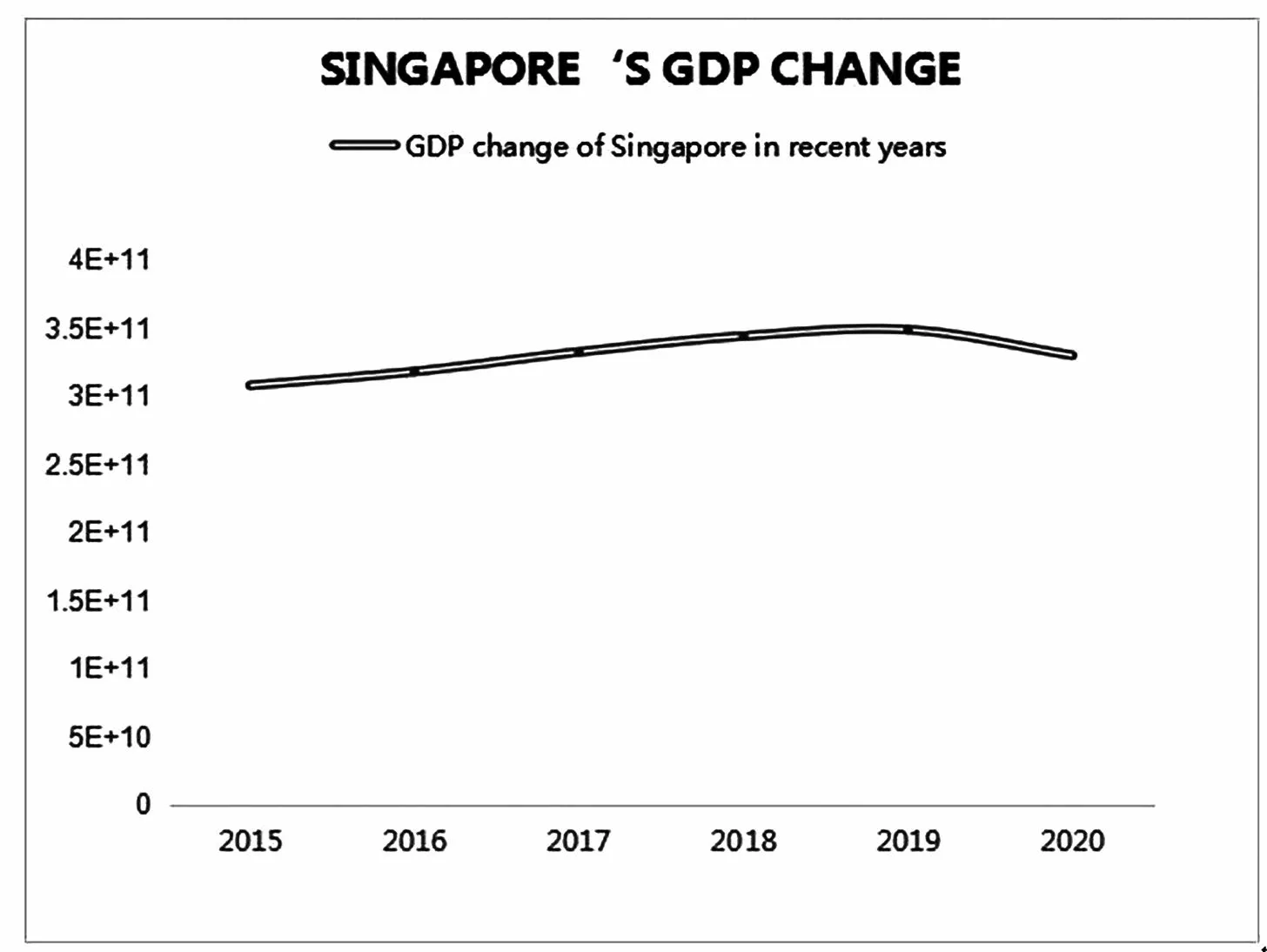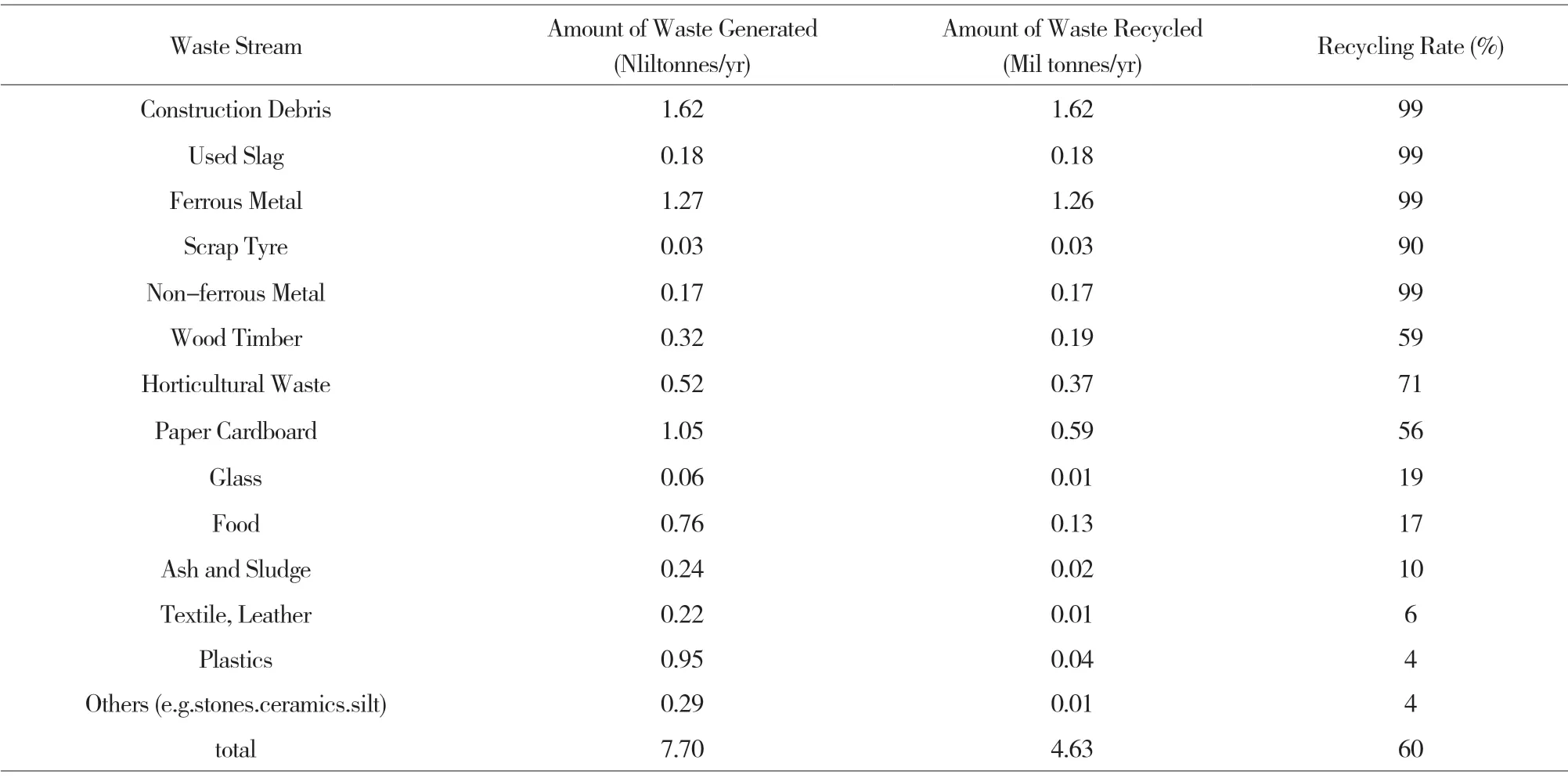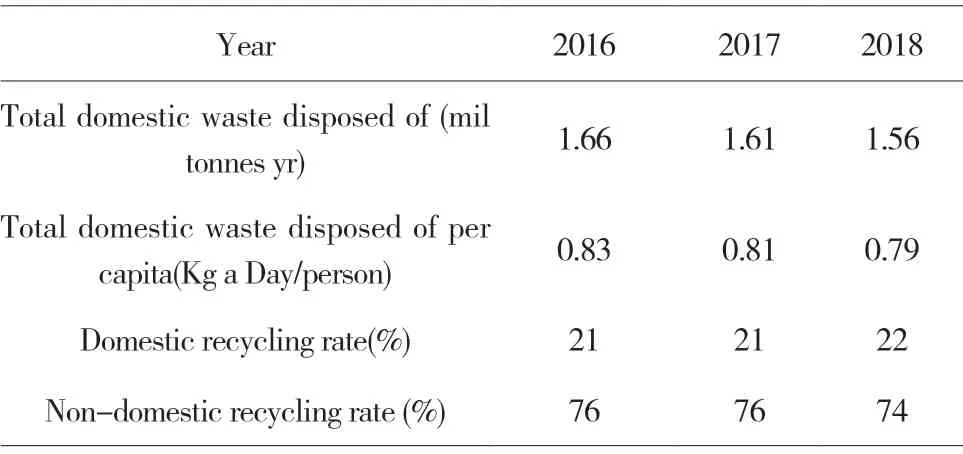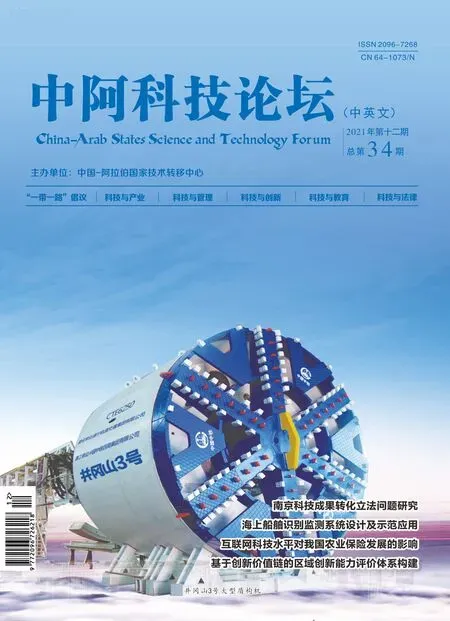Can Sustainable Development and Economic Development Go Hand in Hand
——Taking Singapore for an Example
2021-12-20XiaoLingyi
Xiao Lingyi
(Tianfu College of SWUFE,Mianyang 621000)
Abstract:Taking Singapore as an example,this paper aims to explore whether Singapore has achieved sustainable and economic development at the same time and whether this country pays more attention to economic interests or environmental protection.First,the historical background and sustainable development background of Singapore are discussed,and the data from the environment and water sectors,department of statistics,the world bank,the Asian Development Bank,ASEAN Stats Data Portal and the United Nations Development Agency is quoted to illustrate the current situation of sustainable development in Singapore,the problem of whether Singapore has achieved sustainable development from the perspective of green growth and the existing policies and challenges are discussed in detail.
Key words:Singapore; Sustainable development;Green development
1 Singapore’s Background
1.1 Historical Background
On August 9th,1965,Singapore officially declared its independence.Over the past 50 years,Singapore has gone through the industrialization process of more than 100 years in developed countries.It has entered the ranks of developed countries and is the most competitive urban country in Asia.After the cold war,Singapore has maintained decades of rapid economic development.the service industry and the export of manufactured goods are the pillars of its economy(Lee Goh and Fredriksen,2008)[1-2].The newly-emerged industrialized country enjoys the title of “miracle of East Asia”(Berger,2004).Figure 1 points out that although GDP of Singapore has continued to grow in recent years,its speed has obviously slowed down and nearly stagnated.The global economic slowdown is affecting Singapore in all aspects.

Figure 2 CO2 emissions (metric tons per capita) — Singapore

Figure 2 Singapore waste production

Figure 1 GDP changes of Singapore in recent years
Economic growth is measured by GDP per capita,but it can also be interpreted into other more important things ——better health and longer life,greater economic security.There are also disadvantages,such as the threat of development to the environment (Leys,1996).In Southeast Asia,Singapore represents extreme urbanization.Industrial development is perceived as both a cultural and a national imperative(Levy-Faur,1997)[3].
From 1960 to 1980,the rapid industrialization began,accompanied by land clearing and vegetation cutting (Tan and bin Abdul Hamid,2014).In the second half of the 19th century,more than 95% of the original lowland forests were cut down,Singapore has laid an economic foundation within 30 years and continues to develop at a remarkable rate,especially in high value-added industries and housing,business and service industries.There is almost no vegetation cover (Hesp,1995).At present,23% of Singapore’s land is covered by forests or nature reserves (Castelletta:Thiollay and Sodhi,2005).
1.2 Sustainable Development Background
In the early days of the founding of Singapore,the economy was paralyzed,people lived in poverty,and environmental pollution was severe.It has a small land area but a large population.The inherent disadvantages of natural resources make Singapore carry out many policies on sustainable development.
However,due to geographical restrictions,population,industrial types and other reasons,the country is still exploiting fossil fuels,building minerals,industrial minerals and other resources from the natural environment,which lead to a massive per capita carbon footprint (Tan and bin Abdul Hamid,2014)[4-5].At the same time,the recycling rate is low and it is also known for its energy intensive industries.The above situation is demonstrated through data.
Environmental status in Singapore:
It is undeniable that Singapore,as the most industrialized and urbanized country in Southeast Asia,has made great progress in sustainable development in the past 40 years (Doshi 2013).However,there are still problems due to its own national conditions and development model.
1.2.1 Recycling in Singapore
Although Singapore’s recovery rate has been rising in the past few years,the rapid growth of the economy and population and the change of consumption mode have led to the continuous increase of waste production.Such a recovery and reuse rate does not fully support the sustainable development that Singapore has always advocated[6](Zhang,Keat and Gersberg,2010).
With the rapid industrialization and economic development,solid waste production has increased dramatically,with industrial solid waste being the major source of solid waste.The extremely high recycling cost makes recycling very difficult[7](Bai and Sutanto,2002).It can be seen from Table 1 that the overall recycling rate in Singapore is only 60% and the recycling rate in terms of glass,food,leather and plastic waste are all lower than 20%.Most packaging of consumer goods such as food,beverage and electronic products in Singapore is used only once before they are discarded.Packaging accounts for about one third of all household waste in Singapore,more than half of which is used for food and beverage.Unnecessary packaging not only wastes resources,but also contribute to the generation of waste.Semakau island is the only offshore landfill in Singapore,which can only deal with inert inorganic solid waste,so the vast majority of food waste is treated by incineration due to limited land[8](Khoo and Tan,2010).However,the ashes generated by incineration waste eventually enter the landfill,and a single landfill failed to cope with the increasing amount of waste.Over the past 40 years,with Singapore’s population and economic growth,the amount of waste generated has tripled.In 1970,about 1200 tons of waste were produced per day.Today,production is over 8700 tons a day.What’s worse is that there isn’t enough space to build another landfill.

Table 1 Singapore Solid Waste Management in 2018
Singapore is still a typical consumerist society.In terms of the domestic sector,it does not pay attention to waste production reductionand waste minimization as compared with recycling[9](Neo,2010).From Table 3,it can be seen that in the three-year process,only about 20% of the garbage is recycled in Singapore,and a large number of garbage is recycled in overseas areas,which also greatly increases the cost of garbage recycling.

Table 3 Domestic recycling in Singapore

Table 4 energy consumption in Singapore 2018
1.2.2 per capita carbon footprint in Singapore
There are many difficulties in finding alternative energy sources,and the import of oil is still the main means of energy consumption.Singapore is an “alternative energy disadvantage” country recognized by the UNFCCC.That is to say,Singapore lacks the natural conditions necessary for the utilization of non-fossil energy such as hydro power,wind energy and geothermal energy.As can be seen in Figure 2.Singapore’s per capita carbon emissions were higher than 8 metric tons per capita in 2018.At the same time,China’s per capita carbon emissions were 7.5,while China is still a developing country.
Energy consumption is one of the major sources of carbon in Singapore.Household appliances,transportation systems,industrial and commercial activities are all major consumers of electricity and fuel.However,since negative effects of climate change take a long time to manifest,it is easy for people to consume electricity without realizing the consequences.For the management of renewable resources,there are two recognized principles of sustainable development.First,the yield should be equal to the regeneration rate(continuous yield).Second,the rate of waste discharge should be equal to the natural assimilation capacity of the ecosystem discharging waste[10](Daly,1990).Table 4 shows that in 2018,Singapore is still using a large number of fossil fuels,accounting for more than 95%.The utilization rate of renewable energy is only 0.7%.In 2018,China’s utilization rate of renewable energy was 12.4%.while Denmark’s reached 33.2% (United Nations Development Program).Singapore accounts for about 0.1% of global emissions[11](Ang and Li:2017).It can be seen that Singapore’s utilization rate of renewable energy is far below the global average.Movement towards a renewable energy future will require much greater commitment from cities themselves at all levels[12](Newman:2010).At the same time,forest coverage in Singapore continues to decline.
1.3 Industry in Singapore
So far,the largest industry in Singapore is manufacturing,accounting for 20%-22% of its annual GDP and it is still expanding(Figure 3).Singapore’s major manufacturing clusters include electronics,chemistry,bio-medicine,logistics and transportation engineering.

Figure 3 Proportion of manufacturing GDP to total GDP
According to Table 5,compared with other ASEAN countries,Singapore has the smallest land area but the largest GDP.In other words,energy intensive manufacturing,which contributes the most to GDP,is extremely important to Singapore.

Table 5 Proportion of manufacturing GDP to total GDP
There is no doubt that energy intensive industries consume a lot of energy and exerts a huge impact on the environment,such as chemical industry.This contradicts the sustainable development that Singapore vigorously promotes.At the same time,its significant position in Singapore’s economic development also determines that energy intensive industries can not be restricted or even eliminated in the short term.
2 Green growth and sustainable development of Singapore
Green growth is an indispensable part of sustainable development.As mentioned above,sustainable development is closely related to economic,environmental and social sustainability.We cannot take it for granted that green growth and their ideal coexistence.Green growth policy must be designed reasonably,with improving efficiency and saving cost as the core[13](Fay,2012).
“Green growth”,as a growth mode of “pursuing high-speed economic growth,preventing environmental deterioration,maintaining biodiversity and following sustainable development”,emphasizes the coordinated development of economy and environment,and aims to seek social welfare,improve citizens’ health condition and employment rate,and realize the rational allocation of resources through the change of production mode.With the development of society,the growth mode of this feature is becoming more and more difficult,mainly due to the following reasons:the low-cost advantage of production factors begins to weaken,the environmental carrying capacity is about to reach its limit,and in order to pursue the continuous increase of economic investment and export.
As mentioned above,although Singapore vigorously promotes the sustainable development policy,as a developed island country with regional restrictions leading to low recycling rate,largescale utilization of fossil fuels resulting in a large amount of carbon emissions,relying on energy intensive industries,Singapore’s economic development does not seem to be fully in consistent with green growth.Economic principles show that from an economic point of view,“mining”,consumption or elimination of biological resources is reasonable,and unsustainable production activities may be economically reasonable[14](Tisdell 1988).That is to say,in Singapore,the economy is paid more attention to compared with the sustainable development.
3 Singapore’s Existing Sustainable Development Policies and Challenges
In 2015,the UN General Assembly put forward the sustainable development goals (sdgs) under the 2030 agenda for sustainable development (2030 agenda).Singapore supported the 2030 agenda and released the progress of domestic sustainable development at the meeting.
3.1 Energy Conservation
The energy efficiency program office of Singapore (e2po) is an inter-agency Committee served to improve energy efficiency in various types of activities including home,industry,buildings,power generation,transportation and information communication.In addition to direct measures,the government is also committed to employing innovative technologies to improve energy efficiency.Another important measure is the energy conservation law.The law requires a large number of energy users in the industrial and transportation sectors to appoint energy managers,report on energy use and develop good energy management practices.The law also sets minimum energy efficiency standards for industrial equipment and household appliances.
However,in the process of rapid economic development,even after the industrial transformation,the increase of energy consumption is inevitable.Industry,commerce and transportation are all energy consuming industries.Therefore,for Singapore,how to use energy in a more intelligent way and how to solve the energy problem while ensuring economic development,is still a long-term task.
3.2 Reducing Carbon Emissions
Compared with many types of fossil fuels,natural gas emits 40%less carbon dioxide than fuel oil for each generating unit[15-17](Brown and Yucel,2008).Over the years,Singapore has started to use more natural gas.In the 2017 budget,Singapore’s finance minister announced the plan to levy a carbon tax in 2019.The tax will apply to facilities that emit more than 25000 tons of carbon dioxide per year,targeting six greenhouse gases currently identified in Singapore.The United Nations Framework Convention on climate change (UNFCCC)proposed a carbon tax to achieve a unified price and reduce carbon emissions to some extent.
However,as demonstrated above,energy consumption is the major source of Singapore’s carbon emissions.In other words,these two problems are equally difficult to resolve.Moreover,according to the above data,although Singapore has imported natural gas in recent years,it still faces a lot of carbon emissions.The promotion of natural gas in Singapore has not reached an ideal state.
3.3 Recycling Measures
In recent years,Singapore has set up recycling bins in public housing villages.Two recycling channels are installed on the floor.All condominiums have also been required to provide one recycling per block since August 2018.
However,Singapore’s natural geographical conditions make recycling policy relatively weak.Moreover,if there is no mandatory regulations,the recycling bins set up are likely to fail to play a role.For example,the residents did not classify the garbage correctly as required when discarding them.
4 Conclusion
For Singapore,there are still many obstacles in achieving full green growth.At present,economy development is taken more seriously than sustainable development.Secondly,the large population density and the massive use of fossil fuels have led to a large amount of carbon emissions per capita,which still exist in the current situation of sustained population growth and low utilization rate of natural gas.Finally,Singapore is known for its energy intensive industries.Unless there is a complete industrial transformation in Singapore,the pollution will continue even if a series of environmental protection measures are implemented.
For future sustainable development,it’s suggested that Singapore should slow down the speed of economic development and focus on taking more win-win measures in order to strike a balance between economic development and sustainable development.
